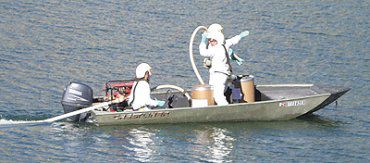By early afternoon of Sept. 22, the long-planned treatment of Ferron Reservoir had been completed. As Division of Wildlife Resources trucks rumbled down the mountain with boats, trailers and equipment in tow, fish were already floating to the surface. A biochemical reaction in the gills was already at work, inhibiting the uptake of oxygen.
The agent used to treat the reservoir was rotenone, a substance derived from the root of a tropical South American plant. Ground up roots have been used by the indigenous people of South America for centuries to harvest fish, and the commercial product has been a valuable fisheries management tool in the United States since 1934.
Rotenone is a safe chemical when used in accordance with the label directions. All members of the team working on the project are licensed pesticide applicators and the two project leaders received extensive training in the use of rotenone through the U. S. Fish and Wildlife Service.
Paul Birdsey, Division of Wildlife Resources Aquatics Manager, stated that even with the knowledge that rotenone is a safe chemical, extra efforts were made to protect all downstream resources in this project. The reservoir was drained to its minimum pool so that the outflow could be shut off completely. Even if any leakage of the chemical did occur through the dam, it would be quickly diluted within a short distance. “With the level of pre-planning that went into this project, we do not expect to see any downstream effects from the treatment”, said Birdsey.
Possibly the biggest public safety concern with treatment projects is the consumption of treated fish. This is not a result of the chemical used, but instead results from the potential of salmonella poisoning from decomposing fish. For this reason, collection of treated fish is not allowed.
The reservoir treatment was first proposed more than a year ago as part of a larger range-wide effort to restore the native Colorado River cutthroat trout and prevent its listing under the Endangered Species Act.
If listing were to occur, it is possible that fisheries management, water use, and grazing in the drainage would be in the hands of federal authorities instead of local and state agencies. The DWR is strongly committed to prevent listing of all species in the state.
“We have worked hard during this project to partner with local entities and the U. S. Forest Service so that local residents retain a say in the management of this resource,” said Birdsey.
Although this project is part of the Colorado River cutthroat trout restoration efforts, fisheries management in the reservoir will retain its emphasis on family oriented recreation. The reservoir will be restocked with native cutthroat trout, sterile rainbow trout and possibly sterile brook trout. No special regulations on the type of angling methods, slot limits or the possession of cutthroat trout are proposed.
“We hope that the anglers will continue to enjoy Ferron Reservoir just as they always have,” stated Birdsey. “In fact, the removal of the current overpopulation of small brook trout may help improve the fishery.”
The treatment phase of the restoration project isn’t complete yet. A follow-up spring treatment is planned to ensure complete eradication of any remaining fish.
Once the spring treatment is accomplished, there will be a short waiting period to be sure the rotenone has degraded sufficiently to remove any possible threat to the newly stocked fish. Restocking is expected to occur before the July 4, 2012 holiday weekend.
Ferron Reservoir treatment to kill fish

"Division of Wildlife Resources personnel distribute the rotenone into the reservoir as part of a Colorado cutthroat restoration project."
